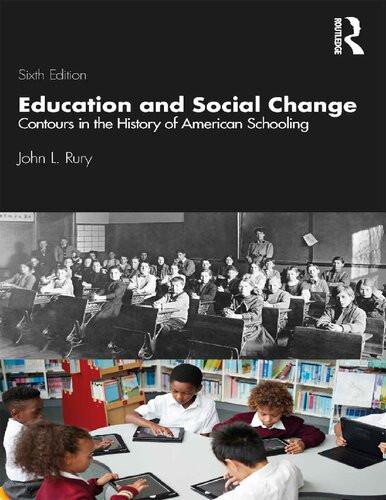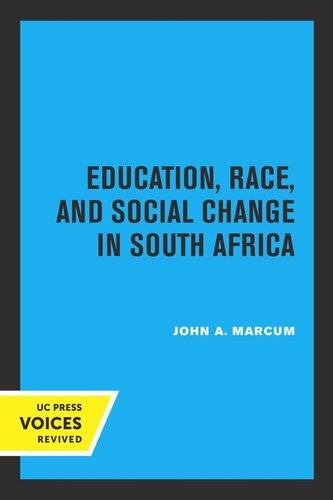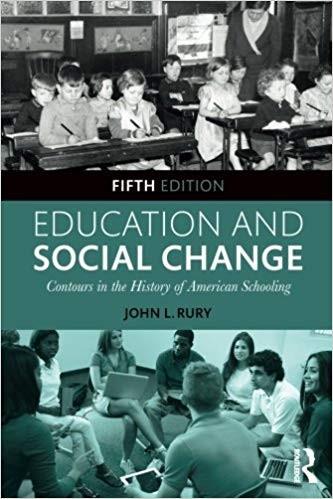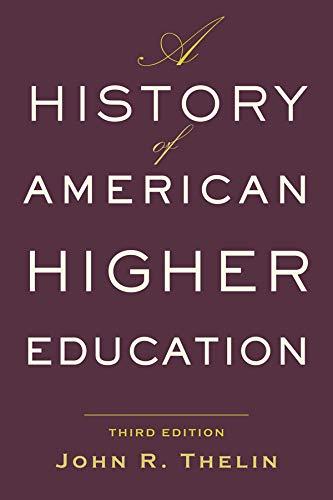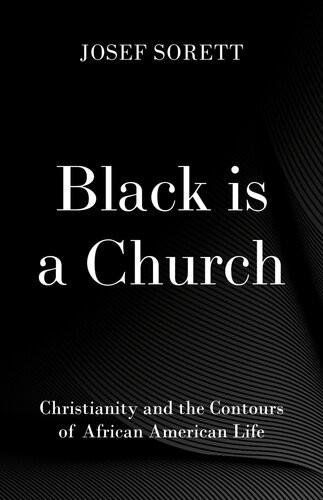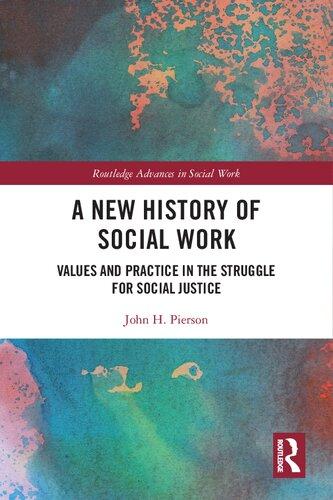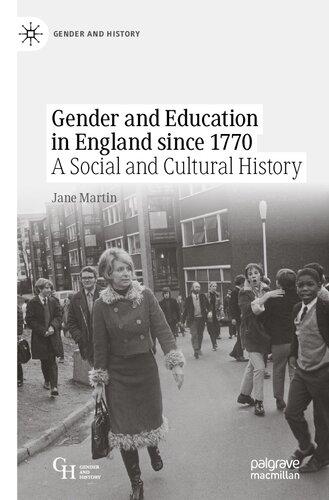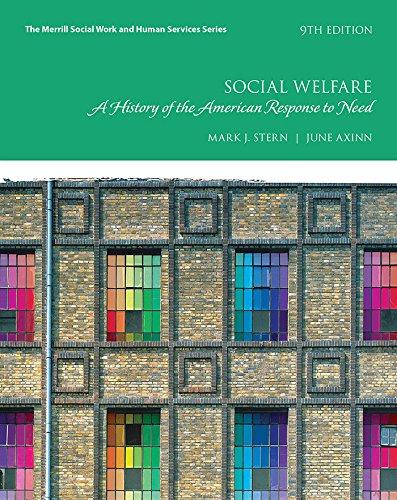Education and Social Change
Contours in the History of American Schooling
Sixth Edition
John L. Rury
Sixth edition published 2020 by Routledge
52 Vanderbilt Avenue, New York, NY 10017
and by Routledge
2 Park Square, Milton Park, Abingdon, Oxon, OX14 4RN
Routledge is an imprint of the Taylor & Francis Group, an informa business
© 2020 Taylor & Francis
The right of John L. Rury to be identified as author of this work has been asserted by him in accordance with sections 77 and 78 of the Copyright, Designs and Patents Act 1988.
All rights reserved. No part of this book may be reprinted or reproduced or utilised in any form or by any electronic, mechanical, or other means, now known or hereafter invented, including photocopying and recording, or in any information storage or retrieval system, without permission in writing from the publishers.
Trademark notice: Product or corporate names may be trademarks or registered trademarks, and are used only for identification and explanation without intent to infringe
First edition published by Lawrence Erlbaum Assoc 2002
Fifth edition published by Routledge 2015
Library of Congress Cataloging-in-Publication Data
Names: Rury, John L , 1951- author
Title: Education and social change: contours in the history of American schooling / John L Rury
Description: Sixth edition | New York: Routledge, 2020 | “First edition published by Lawrence Erlbaum Assoc 2002”
Tp verso | “Fifth edition published by Routledge 2015”—Tp verso | Includes bibliographical references and index.
Identifiers: LCCN 2019012765 | ISBN 9780367242954 (hardback : alk. paper) | ISBN 9780367242978 (paperback : alk. paper) | ISBN 9780429281617 (ebook)
Subjects: LCSH: Education United States History. | Educational sociology United States. | Social change United States.
Classification: LCC LA205 .R67 2019 | DDC 370.973 dc23
LC record available at https://lccn.loc.gov/2019012765
ISBN: 978-0-367-24295-4 (hbk)
ISBN: 978-0-367-24297-8 (pbk)
ISBN: 978-0-429-28161-7 (ebk)
Typeset in Minion by codeMantra
Preface
Acknowledgments
Introduction: History, Social Change, and Education
1 Colonial America: Religion, Inequality, and Revolution
2 Emergence of a Modern School System: The Nineteenth Century
3 Ethnicity, Gender, and Race: Contours of Social Change in the 19th Century
4 Growth, Reform, and Differentiation: The Progressive Era
5 Education, Equity, and Social Policy: Postwar America to the 1970s
6 Globalization and Human Capital: From “A Nation at Risk” to NeoLiberal Reform
Epilogue: Education and Social Change in Perspective
References
Index
Preface
It is a familiar commonplace that the world is changing rapidly. We live in a time of sharp social and political divisions, marked by rapid social change affecting billions of lives. Disputed goals and critical problems face the nation, as issues are contested zealously, from economic policy, to deprivation and inequality, to the environment and a host of other issues. If there is anything that most Americans seem to agree upon, however, it is the importance of schools and education. Without expanding our present knowledge and abilities, we surely will fail to meet the challenges that lay ahead.
The many disagreements of our time also reveal how far we have come, and how we often take the conditions of daily life for granted. Technology has made many wonderful advances: We travel in elaborate flying machines, live and labor in secure dwellings, and communicate across great distances instantly At the same time, our values have changed too, though perhaps less dramatically. Today, we publicly object to discrimination, celebrate equality, and cherish freedom, even if such sentiments are not universally shared. We also hold great faith in the power of education. These facets of contemporary American life, however, are relatively new in historical terms. To one extent or another, they are the result of a complex process of social change that has unfolded over many decades. They are also the result of human sacrifice and struggle, a continuing process of conflict and change. This course of events continues today, and has come to impact much of the world. It is partly what accounts for the zeal of debates today. But understanding this process of social conflict, transformation, and renewal is critical to appreciating who we are, and how we can deal with the challenges that lie ahead. It is to such tasks that this book is dedicated, focusing on the history of education as a condition and manifestation of social change.
This is a book largely about the past, addressing a far-reaching and complex topic. Its purpose is both analytic and descriptive,
recounting what transpired and explaining how and why events have taken a particular path. Finding the proper balance between these goals has often proved trying. But I hope that the narrative ahead is testimony to the worthiness of the goal. It is meant to be an aid for readers beginning to think about these questions, although I hope that others also find it interesting and useful. As John Dewey pointed out many years ago, the ultimate role of education is preparing for an ongoing and inescapable process of change. Understanding this may be our best hope for posterity, and studying its history can help a great deal.
History, Social Change, and Education
This book begins with a simple query: Do schools change society, or does society change the schools? Obviously, the answer is more complicated than the question suggests. Influences run in both directions: Education clearly affects social development, and schools also reflect their changing context. Still, the question of basic influence remains. Can schools function as instruments of social transformation? Or are they constrained by larger cultural, economic, and political forces?
History can address such puzzles. Reformers have long believed that education can remedy social problems, and many have vied to do this through schooling. But critics also raised nagging questions: Is educational reform potent enough to affect sweeping change? Or is its impact more limited, destined to ultimate disappointment? This is a persistent dilemma, for Americans have placed uncommon faith in the power of education. As historian Henry Perkinson noted, schooling has been an “imperfect panacea” for curing the nation’s ills, often promising changes it failed to deliver (Perkinson, 1968). But he also said little about what it could do.
Education includes a broad range of activities, but this book focuses on schools and other institutions of formal education. It does not pretend to be comprehensive. Instead, as the title suggests, it is thematic, focusing on events that help illuminate patterns or “contours” in the past. By examining key steps in the evolution of institutions, it is possible to see how education was linked to social transformation.
The book’s principal goal is to help with thinking about history and social institutions such as schools. In doing this, it draws on ideas from the social sciences. It is important, in that case, to devote some attention to a few of these concepts. At the same time, it is also
helpful to consider the significance of terms such as “education” or “schooling” and “social change.”
Why Study History?
Some people enjoy reading history, others dread it. But, beyond this, does it have any particular value? To grasp educational problems, after all, examining history can seem pretty silly. It may appear more practical to simply examine pertinent data and devise workable solutions to current difficulties How can experiences from the distant past help anyone today?
Things change, but original circumstances often have a big impact on their subsequent development. It is commonplace to observe that today’s society is different from not so very long ago, and yet certain aspects of life remain familiar. “The more things change, the more they stay the same” is an old saying that reflects this perception. It conveys the point that continuity exists in the wake of change, and underscores the importance of studying history to understand exactly what is similar and different (Nevins, 1938). Understanding today’s problems sometimes requires looking to the past to find their roots. That can enhance the likelihood of finding effective solutions.
History also reminds us that others have faced significant problems too. People today often remark that change is occurring faster than ever, but the present is hardly unique in this respect. Indeed, ours is an era of considerable stability, even if technology and knowledge are rapidly advancing. Truly revolutionary change occurred in the more distant past (Aghion & Williamson, 1998). And it was those earlier developments that set the stage for today. One of the values in history, consequently, is to appreciate the origins of our own time, and the challenges faced by those who came before us (Tuchman, 1978).
What does this have to do with education and schools? Like social change, education also is a knotty subject. On the one hand, it is an intricate process of human growth and development, which everyone has experienced (Dewey, 1938). It also entails the transmission of knowledge and values from one generation to the next. And because education is linked to power and social status, it is subject to almost
constant debate. In its institutional form, education has become integral to imparting and certifying skills and knowledge seen as critical to economic status, making it a topic of intense public interest. Understanding education in its many dimensions, consequently, can be a daunting proposition.
Because of its manifold purposes and functions, education often has been a centerpiece of important periods of change. It has contributed to economic growth and political shifts, and it has helped to forge a national identity for different cultural and social groups. Of course, the experience of education itself also has evolved over time, influenced by the economy, the political system, and other facets of the social structure. Schools today are quite different from those in the past, and their purposes have changed somewhat too.
It is possible to say, then, that education has been on either side of social change: both as a causal agent and as an activity influenced by other factors. The link between education and society, however, is continually evolving. This makes it especially interesting as a topic of study, and a means for reflecting on the present.
Thinking about Social Change
Like historians, social scientists often study large-scale social change, and offer ideas and propositions about society to test and refine with historical evidence (Abrams, 1982; Skocpol, 1984; Smith, 1991).
Some of these concepts have become everyday terms of conversation. They assist thinking by organizing facts, values, beliefs, and theories to understand the world more easily. A good illustration is the idea of industrialization, which can be interpreted a number of ways but usually concerns technological development, economic growth, and population movement. In academic parlance, abstract ideas like this often fall into the realm of social theory, and they can help in understanding large-scale shifts in society Whatever they are called, it is important to consider just how historians and social scientists have used such concepts. Social change is difficult to define, but certain ideas can help to identify its many dimensions.
The most pertinent social science ideas are those that describe vast processes of transformation. Industrialization may be the most familiar example, representing changes in the organization of work that accompanied mass production manufacturing. Historically, this first occurred in Great Britain, between 1750 and 1850. It appeared a little later in the United States, in the mid-19th century. And it developed even later in Japan and other countries. Wherever it happened, however, industrialization had a profound impact on the people who experienced it, and it has produced a lasting effect on the organization of society (Ashton, 1948; Brownlee, 1979).
This can easily be seen in history. Before the industrial revolution, most people lived in the countryside, surviving by subsistence agriculture and local crafts. These conditions changed dramatically with the rise of industry. Large numbers of people found employment in factories and related occupations (such as transportation), and moved to cities where they consumed goods produced elsewhere. They worked longer hours, typically performing work dictated by machines. Industrialization thus meant more than just a change in production; for many people, it meant a whole new way of life (Laslett, 1965).
Industrialization caused many aspects of society to change. For most people cheaper, mass-produced goods meant a rising standard of living. But, for many, it was also a time of wrenching dislocation, especially those forced to seek work in burgeoning cities. In the United States, industrial workers often came from Europe, traveling thousands of miles to seek employment. This frequently led to cultural conflict and political tensions. It also held important implications for education, as schools struggled to prepare their students for a rapidly changing world (Rabb & Rotberg, 1981).
Change did not occur just in the cities. In the countryside, farm machinery and modern horticulture also reorganized work. Among other things, this often meant that fewer workers were needed. Such developments had important implications for education, as schools were expected to prepare youth for new jobs elsewhere. Technological change often required new skills, different work habits and greater efficiency, all of which schools could help to foster (Cowan, 1997).
Yet another concept associated with social change is urbanization This refers to the changing spatial arrangement of society, particularly the growth of cities and the many social questions that came with them. The rise of factories meant ever more people crowding together, sharing space, and competing for influence and resources. This, in turn, entailed the development of not only institutions such as schools, but also churches, reform groups, charities, and a host of governmental entities to insure social stability. As cities grew, they became more complicated, and finding new ways of managing their increasingly diverse citizenry became a major challenge (Monkkonen, 1988; Rabb & Rotberg, 1981).
These changes augmented the importance of formal education. With the growth of large cities, social scientists documented social behavior peculiar to urban settings. People were constantly coming and going, and close personal relationships became more difficult to sustain. Urban residents began to relate to one another in functional terms, and some believed that social cohesion began to weaken. Historically, it appeared that shared norms and expectations eroded, and familiar social controls lost their significance—often contributing to greater delinquency. More formal, institutionalized systems of socialization and discipline, such as the schools and police, gained new significance (Schnore, 1965, 1974).
Such developments were manifestations of social change, and education became more important in certifying individual abilities and moral character. As the social scientists put it, secondary relationships based on status and accomplishment were substituted for firsthand knowledge of a person’s past, and formal credentials became increasingly significant. New patterns of behavior evolved rapidly, and observers noted the emergence of an urban culture largely defined by status symbols (Palen, 1997). These were signs of the modern age, but, for many Americans, they were a disturbing change.
A related concept of more recent vintage is Globalization, which refers to the increasing inter-dependency of economic, cultural, and political developments around the world. Like urbanization, it is essentially concerned with spatial relationships, and ways that activities in one domain or another come to transcend nations and
even continents. Globalization is associated with rising international trade, transportation, and communication, and greater movement of people across borders. It has become a widely used term, particularly following a decline in the Cold War and the rise of digital communications technology thereafter (Stiglitz, 2003).
Like industrialization and urbanization, globalization also has a history. “World-System” scholars argue that globalizing influences have been evident for several centuries, extending back to colonial development and the rise of trade between Europe and other continents (Wallerstein, 2004). Economic historians maintain that the first “modern globalization” occurred during the era of rapid industrialization, when a growing volume of trade and millions of people moved freely around the world. World War I and the Great Depression put a stop to it, but globalization began to be evident again following World War II, when the United States emerged as the world’s principal economic, political, and cultural power. Due partly to American influence on trade and freedom of communication, it has accelerated in recent decades, a development with important implications for education (Aghion & Williamson, 1998).
Globalization is also linked to the idea of a worldwide division of labor, with national economies playing new roles in the production of goods and services. Manufacturing, for instance, has been moving to countries with lower wages for decades. In more developed countries, on the other hand, technological development has led to demand for more skilled workers, and the rise of service employment has contributed to higher educational expectations. Given this, it is telling that the biggest complaints about globalization come from people with less education, while its advocates tend to be collegeeducated. Regardless of this, however, there is little doubt about that globalization represents a transformative force in recent history (Applebaum & Robinson, 2005; Osterhammel and Petersson, 2009).
As suggested above, social scientists and historians have long noted that industrialization, urbanization, and globalization have been linked to a more highly defined social division of labor. Indeed, increased specialization in occupations was almost axiomatic during industrial development; it was one of the chief ways productivity gains (making goods at lower cost) have been realized historically.
At the same time, as urbanization advanced, there was a sharpening division of labor in the occupational structure of cities. Larger places developed more specialized occupations and services. This too was an important manifestation of social change, as only the biggest cities have the population base necessary to support highly specialized or narrowly focused activities and interests. And, of course, the growing international division of labor is perhaps the single most controversial aspect of globalization. Thus, the historical development of the division of labor has been linked to each of these concepts. Because the division of labor is closely tied to the need for new and different types of knowledge and skills, it has had profound implications for the development of education (Hawley, 1950; Stiglitz, 2003).
The division of labor is linked to yet another enduring concept in social theory: class conflict. This idea is often associated with social inequality and the development of the capitalist economic system. Karl Marx, the famous German revolutionary and philosopher, was probably the best-known proponent of the view that capitalism inevitably produces such inequities, but it had many other adherents too. Today social scientists continue to debate such questions, but few dispute the importance of systematic inequality based on the type of work people do or how much wealth they command. And when such inequalities grow extreme, conflict can erupt. Historically, as the division between rich and poor widened, Marx and others predicted that the working class would come into conflict with the capitalists, owners of the means of production (Wright, 2005, 2016).
There is evidence of this in history, even though the Marxist apocalyptic vision did not materialize. With industrialization, especially the development of the factory system, differences between social classes were aggravated. This led to socialist movements, relatively small in the United States but larger elsewhere, and the development of modern labor unions. Historically, there was considerable strife over the rights and living standard of workers. This too was an important element of social change. These conflicts included battles over education and schooling, especially in the nation’s growing industrial cities (Bowles & Gintis, 1976).
Industrialization, urbanization, globalization, the development of technology and the division of labor all have been important aspects of social change as it has unfolded in the United States. They also are practical concepts, developed to explain extensive alterations to the social order. As such, they are vital to the task of comprehending just how education and social change have been related. But these are hardly the only ideas relevant to historical reasoning. Many additional social science concepts also are pertinent, most of which deal less directly with large-scale transformation. But they too can be very useful in understanding social and educational change in the past.
History and Social Theory
One of the goals of social science is to establish basic categories of collective experience, to help explain behavior in a variety of settings. Such conceptions are the elements of social theory, and they are critical to making sense of social change in history.
A good example of this, and a very familiar one, is evident in the term culture. Broadly defined as the way of life in human society, culture can be considered behavioral characteristics or traits typical of a social group. These usually include rituals or ceremonies, customs, attitudes and ideas transmitted from one generation to the next. The tricky part is identifying these traits when they are considered normal. Because it is so encompassing, culture can be a slippery term to define precisely. But it is indispensable in explaining the process of social change, especially on a larger historical scale (Kluckhohn, 1949; Kuper, 2000).
Culture is especially pertinent to schooling, as education can be defined as a form of cultural transmission. If society is to function smoothly, familiar and productive attitudes and values need to be taught to each succeeding generation. This does not mean that such ideas are always accepted; the young often reject aspects of the dominant culture. When this happens, it often represents cultural change. And because schools are directly involved in teaching ideas and shaping attitudes, they stand at the very center of it. A major
issue in the history of education, consequently, concerns cultural transformation (Spindler, 1963).
Social scientists have used the idea of culture to pose yet another concept: cultural capital. It is premised on the recognition that all cultures are not valued equally. In the United States, for instance, certain forms of behavior, values, and attitudes are more admired and rewarded than others. This is evidence of a dominant culture that can dictate many traditional values and tastes. The concept of cultural capital thus can be linked to social status. Certain ways of speaking, dressing, and conducting oneself, after all, are associated with greater standing or prominence. For example, an English accent is often favored over a Spanish one; suits are typically seen as higher status than jeans and tee shirts. Knowledge of classical music or jazz is often taken as a sign of sophistication, as is familiarity with fine wines. This sort of knowledge can represent cultural capital, a command of information and abilities that are valued by others with higher standing. Those who possess such knowledge and skills often have access to greater social benefits. Those who lack it are frequently considered to be inferior. In this respect, cultural capital is related to status and social inequality.
Cultural capital can also find expression in more significant ways. It can take the form of a large vocabulary, for instance, a welldeveloped understanding of history, or ability in a foreign language— especially a high status one such as French. It can have more practical dimensions too, such as understanding how institutions function or how to behave in certain situations, like being a good conversationalist or even doing homework on time. Individuals who possess these traits hold advantages in social life and often enjoy greater esteem as a consequence. It is in this regard that the term capital is fitting. Because these characteristics or conditions empower individuals to do things that provide social benefits, they can be considered a tangible form of wealth (Bourdieu & Coleman, 1991; DiMaggio, 1982; Lamont & Lareau, 1988).
Schools can assist in realizing such benefits if they grant the holders of cultural capital greater access to credentials or other forms of recognition. A large body of research demonstrates that cultural capital is an advantage in educational institutions (Lareau &
Horvat, 1999). Children with highly educated parents, for instance, have access to books, music, magazines, and media technology that may impress their teachers. They also learn to speak properly and have opportunities to travel and visit museums and other cultural institutions. Parents who understand how complex organizations function can provide children with even more advantages. Every historical period has had some form of cultural knowledge that can be passed across generations. Consequently, cultural capital is a useful concept in studying education, even if its meaning may shift from one historical setting to another (Kalmijn & Kraaykamp, 1996; Roscigno et al., 1999).
Another social science term that has gained currency is social capital. This idea is parallel to cultural capital, but conveys a somewhat different point. Social capital refers to advantages that individuals derive from relationships. As sociologist James Coleman pointed out, in order for cultural capital (socially valued knowledge and skills) to be conveyed across generations, there must be positive and sustained relations between adults and children. In this respect, supportive relationships can be a valuable asset, and hence a form of advantage or capital. Within groups, it can reinforce dominant attitudes and behavior, as long as strong relations sustain them. Social capital can thus help to perpetuate beneficial dispositions, values, and behavior within social groups. As Coleman noted, it can also be efficacious in networks of association and influence. Knowing the right people to secure a certain advantage, such as lawyers or bankers, can be considered a form of social capital. Tightly knit communities, where people help one another with all types of problems, offer valuable social capital to their residents. When members of these communities encourage values that encourage socially responsible behavior, such as maintaining a job or attending school, it can represent a form of cultural capital that is a tangible benefit of social capital (Coleman, 1988).
Regarding education, a telling example of social capital is the effect of local communities on school attendance. Some social groups seemed to encourage regular enrollment more than others. The children of Jewish immigrants had unusually high levels of school attendance in the early 20th century, even though their
parents often were poor and lacked formal education. Similar patterns have been observed more recently among Asian Americans. Some of this appears to have been linked to attitudes that young people should spend time in schools and strive for success. This is clearly a form of cultural capital, but its realization depended on the close relationships between adults and children, ties that helped to transmit these advantageous values. Historically these groups did not have many conventional forms of cultural capital, such as knowledge of American customs or proper English. The school was an institution that helped develop these traits, but these children’s success was influenced by relationships with adults in the community. In the case of immigrant groups with comparatively little native cultural capital, social capital was a resource that helped them to overcome disadvantages. If a community is quite cohesive and can persuade or compel the young to excel in school, the influence of social capital is typically a factor (Perlmann, 1988; Rotberg, 2001; Zhou & Bankston, 1994).
Of course, this can also work in the opposite direction. There have been groups that have shunned the schools, discouraging their children from attendance. Italian immigrants, for instance, sometimes told their children to leave school and find jobs to contribute directly to household income. These relationships transmitted values that did not represent a form of cultural capital in the larger society, even if it immediately afforded families greater resources. As Coleman suggested, social capital is highly situational. Indeed, if community relations have a contrary impact on school success, children may be disadvantaged. Some social scientists have described this as negative social capital, as it represents relationships that can be problematic. In any case, a tightly knit community with broadly shared values and expectations can contribute to social capital if it results in tangible, enduring advantages in the larger social context (Perlmann, 1988; Portes, 1998).
Social and cultural capital are useful concepts for explaining why some individuals and groups succeeded historically and others did not. In this respect, both are related to the economic term human capital, which refers to differences in skills and knowledge that help explain why some people—and groups—are more economically
industrious or productive. Lawyers and doctors, for example, can perform tasks routinely that would take less knowledgeable people much longer to complete, if they could do them at all. The same principle applies to accountants, engineers, computer programmers, teachers, and most other jobs that require advanced levels of training. This, according to economists, is the reason why people with higher levels of education usually earn more money than others. Human capital has become a critical component of the modern economy (Becker, 1964). To the extent that social and cultural capital can contribute to opportunities to acquire human capital—typically through school or other types of formal training—they can help improve social status.
These different conceptions of capital are important to understanding the development of modern school systems. Human capital—skills and comprehension—is usually seen as an outcome of schooling, while cultural and social capital—socially helpful knowledge and relationships—are typically considered helpful for success in schools. In all three examples, however, capital represents a palpable resource that can be drawn upon for social or personal advancement. Broadly speaking, culture and capital are concepts that help to characterize people and groups, and they allow greater understanding of human differences. Together, these are ideas that have special significance in research on education, and they are relevant to educational history as well (Rury, 2004).
People who occupy different positions, of course, often view the world in quite dissimilar ways. Social scientists use the term ideology to represent systems of ideas and beliefs that people use to interpret their circumstances and guide their actions. This is yet another critical concept in comprehending the relationship between education and social change, and it is clearly connected to the definition of culture discussed above. One useful way of distinguishing between them is to think of culture as principally representing attitudes and behavior, and ideology as limited to beliefs and ideas, even though each influences the other. As historian Carl Kaestle has noted, in the United States, ideology has been strongly linked to Protestantism and a battery of ideas revolving around the capitalist economic system: private property,
hard work, and self-denial for purposes of advancement. These somewhat disparate ideological elements have worked together historically to form a coherent worldview that has shaped politics and institutions. There are other aspects of ideology, but as noted above, the development of values and attitudes is clearly a crucial component of schooling. Consequently, ideology has been a critical factor in the development of education (Kaestle, 1983).
Like culture, ideology is a tricky concept because it is an aspect of everyday life. History, however, provides a useful means of examining its effects on familiar institutions and events. Racism and sexism are collections of ideas that hold certain groups of people to be inferior to others, notions that historically have had a profound effect on American society. Racism is an ideology that suggests African Americans and other groups should be seen as biologically different, mentally inferior and less deserving of social status than others, particularly Whites. Sexist ideology holds that women are inferior to men in terms of intellect and physical stamina. Both have exerted powerful influences on popular thought and behavior in U.S. history. Obviously they also have held important implications for education, and for the development of schooling in the United States (Guillaumin, 1995; Omi & Winant, 1994).
Ideological beliefs such as these have resulted in overt and covert efforts to limit or constrain the educational prospects of children from certain groups in American history. Researchers have used the term opportunity hoarding to describe such practices, as access to schooling and the benefits it affords have often been reserved for the children of favored social groups, while others have been largely excluded. This was evident in racially segregated education systems in the South for many decades, when better funded schools were designated for whites only. The same could be said of policies that sent American Indians to special schools intended to eradicate their cultural heritage, or the practice of relegating disabled children to custodial institutions. It was also manifest in rules that denied women access to the nation’s most elite colleges and universities for more than a century. And it clearly existed in suburban communities that resisted the efforts of poor and non-white families to settling within their school districts. These actions perpetuated social and
educational inequality, denying many generations of Americans the same opportunity to realize their potential that others have enjoyed. As such, opportunity hoarding can clearly be described as an especially potent form of social injustice (Anderson, 2010; Rury & Rife, 2018; Rury & Saatcioglu, 2011).
There is more to the question of ideology and its impact on education, however, than the distressing legacy of racism, sexism, and opportunity hoarding. Yet another aspect of popular ideology in this country has been equity—or the principle of equality of opportunity This idea is associated with such other familiar features of American ideology as freedom and democracy, and the famous refrain, “all men are created equal.” Of course, these sentiments are contradictory to racism and sexism, and other ideas that inhibit social groups because of biological or cultural traits and through practices such as the hoarding of educational opportunity. It has often been noted that American life is riddled with such incompatible elements. But conflict over these issues has helped make the United States such a dynamic society, and helps to account for its rapid pace of social and institutional change. The ideals of equality and the freedom to gain access to schooling have animated social movements to remove barriers to opportunity, and their successes eventually became manifest in many of the enlightened public policies that exist today. Even so, the nation’s school system continues to struggle with many of these questions (Ravitch, 1983).
Concepts such as culture, industrialization, urbanization, globalization, social and human capital, ideology, opportunity hoarding and equity can assist in thinking more clearly about how society changes, and the ways in which this process has affected people’s lives. In the case of education, these concepts are helpful in interpreting just why schools and related social institutions, such as families and other agencies of socialization, have changed over time. Schools evolved a great deal in the past several centuries. As suggested earlier, studying this process can illuminate just how these institutions and the larger society have interacted over time.
